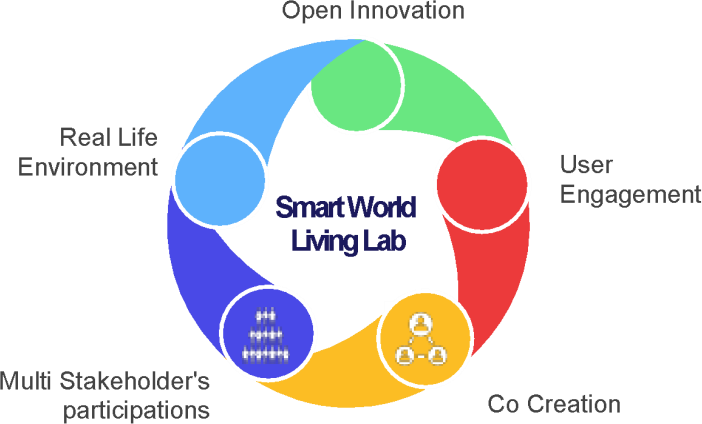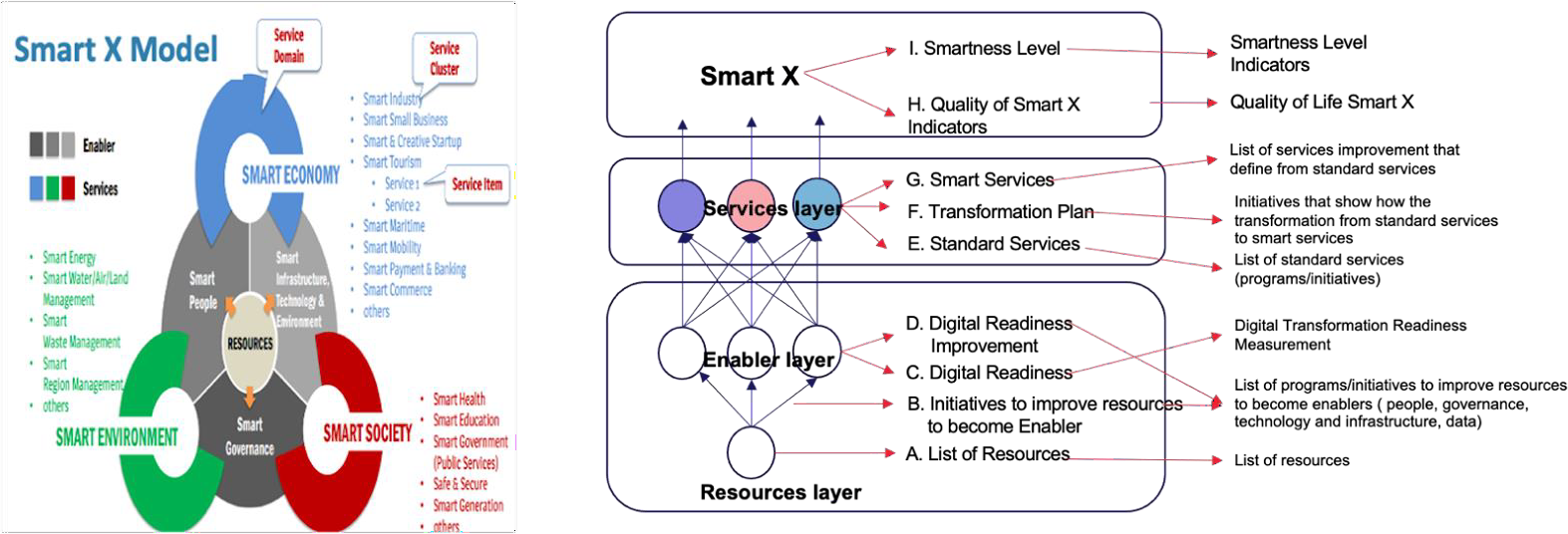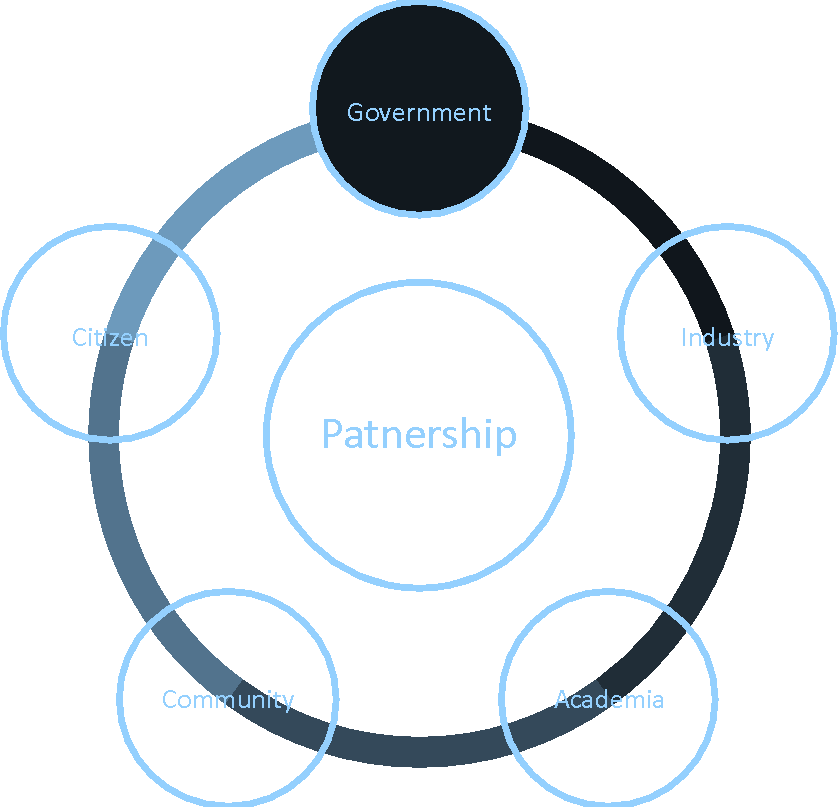This Policy Brief proposes the G20 Smart World Living lab (G2SWL) as an approach to solving problems in a small-scale area and real-life conditions by involving various stakeholders and community engagement. The objective of G2SWL is to solve problems on a small scope and evaluate them before deployment on a larger scale. Generally, our proposals are threefold: 1) the G2SWL to solve problems in a small and manageable area and establish a living lab as a shareable lab and real-life lab to test solutions, and 2) stakeholder engagement for living lab development, and 3) creating a network hub for living lab development among G20 countries.
Challenge
The increasing urbanization flow affects the increases in urban challenges. Many smart solutions appear to solve the socio-economic, environmental, transportation, education, and health problems, including reducing carbon emissions, and yet they pose a complex challenge and risk of failure in their implementation. For instance, the performance of smart payments in a tourist area causes a decrease in income between 20 and 40 percent per week (RKCI, 2017; Firmansyah, 2019). Bain (2019) generally mentions that smart solutions and digital transformations promoted by large corporations show as little success as 5 percent, while the remaining 20 percent have failed, and 75 percent are not in line with the targets. This shows that technology deployments were counterproductive because of non-technical issues, stakeholders’ involvement, regulation, and local wisdom.
Schuurman (2014) and our Smart City Rating Research in 2021 summarized the challenges and failures encountered in implementing these smart solutions as follows:
- The suitability of the smart city concept applied to city conditions
- The scope of implementation is too broad (does not start from a limited scope)
- The impact is not felt directly by the community
- Too focused on technology development, forgetting about governance and changing the mindset of Human Resources for the better
- The lack of evaluation of the implementation carried out in the city area
- Solution implementation does not start from Basic Value, instead focuses on Additional Value
- The process of implementing management, especially sustainability, is not carried out optimally
- The emergence of counter-productive initiatives
- Lack of adequate public participation.
These challenges and failures indicate that implementing a smart solution is not easy, and that it requires a unique approach in handling them. Living Lab (LL) is a feasible approach to solving this problem by deploying smart solutions at a specific location with a real-life environment that involves stakeholders to measure its effectiveness and provide feedback for improvement sustainability that benefits them. The LL uses real-world data to solve real-world problems using co-creation. It is an attempt at solving urban issues within a small scale and limited environment. After evaluation and positive results, we may implement it in different or larger areas.
G20 Smart World Living Lab (G2SWL) proposes a concept to solve problems in a small-scale area by involving multiple stakeholders. The aim of G2SWL is to solve the world’s problems on
a small scale and evaluate it before implementing them on a larger scale. The Implementation of G2SWL uses data supported by the optimization of city enablers (people, governance, and technology) in the context of co-creation. We also propose G2SWL as a shared laboratory and knowledge center for G20 members. Every year the results of this lab will inform policy making.
Proposal
Based on the abovementioned problems, we propose that the concept of sustainable development is used to solve the world’s problems gradually and sustainably as a policy. The idea is to implement a LL based on accurate data and using all data to solve problems in a small area. A LL is a real-world laboratory that uses actual data to solve the real problems based on multi-stakeholder co-creation (Higgins 2014). LL is also the orchestrator of innovation processes focusing on co-creating innovation in a real-world context by involving multiple stakeholders to generate sustainable value for all stakeholders (Ståhlbröst, 2016). In other words, a LL is a multi- stakeholder organization set up to carry out innovation projects that follow the principle of open and user innovation and focus on a real-life experiment (Schuurman, 2014)
The G20 Smart World Living Lab (G2SWL) is a suitable approach to support the realization of collaboration between government, community, industry, education, and civil society to solve problems. The three recommendations we are proposing in this Policy Brief are straightforward: building a living laboratory on a small scale based on the problems and data we have, then expanding the results..
Proposal 1. Promote the G20 Smart World Living Lab (G2SWL) as an approach to solving problems in a small and manageable area
We develop the G2SWL as an approach to solve the problem of implementing the smart solution in a small area by involving multi-stakeholders to solve problems in real-life conditions and the impact directly felt by the community. In implementing the living lab, the G20SWL has several characteristics that enable a successful implementation.

Figure 1. G2SWL Smart World Living Lab Concept
Based on the characteristics of the LL, the key factors required to implement G2SWL are as follows:
1. Open Innovation
The first step of the LL approach is to identify the problem and provide alternative solutions to solve it. The concept of open innovation becomes the core of choosing alternative solutions. Open innovation is a process where people or stakeholders seek and commercialize innovative ideas from outside the organization. Open innovation aims to create close collaboration in research and development, new product design and development, and market introduction with stakeholders who will share interests in the collaboration
2. Real-life environment
LL basic concept is how to build laboratories in the real world; through this approach, the G2SWL proposes the use of a real problem in a real-world condition where the scientist will directly interact with the problem or the local community, so the result from the implementation can give a direct impact to the community.
3. Multi-stakeholder participation
Stakeholders become key players in solving problems and building a LL. We propose a multi-stakeholder involvement in making a LL. Each stakeholder will have a role in implementing a LL. Stakeholders include the government, scholars, industry players, the local community, and civil society.
4. Co creations
Co-creation is a business strategy to combine ideas and thoughts from stakeholders. In a LL, co-creation plays an important role in inviting all stakeholders to have a contribution and collaborate to provide a solution to the problem based on their expertise.
5. User engagement
User engagement is how to increase users’, in this case, the local community and other stakeholders’, awareness and desire to be involved in using services or solving city problems.
The G2WSCL is a proposed LL that solves problems in small areas (roads, campuses, villages, cities, districts) and real-life conditions. The objective of the LL is to improve life’s quality, solve problems, and maximize the region’s potential by continuously evaluating real problems in an actual environment. The LL enables prototyping of technology, governance, and human resource development, creating a sandbox for a new startup and providing a knowledge center to deliver problem-solving for G20 and other countries. It is also a shareable lab as a learning hub with G20 countries in particular conditions for problem-solving in Indonesia or other countries.
LL aims to improve the quality of life with sustainable solutions and provide impacts and benefits that the community can directly feel. We promote four main activities to establish a LL as a pilot project or incubator for smart solutions to solve problems. Steps are shown in Figure 2.

Figure 2 The G2SWL activities
The four activities to implement G2SWL follow the process of PBRE (Plan, Build, Run, Evaluate).
- Plan: area identification and measurement of existing conditions to identify problems and alternative solutions. This activity can be carried out through a forum group discussion or direct surveys. The output of this activity is the selected area, the existing area condition, and the alternative solution proposed in the area.
- Build: choosing the best solutions from the alternative solutions proposed in the first step. The output of this activity is the solutions that will be implemented and stakeholders that will implement them.
- Run: the simulation or implementation of selected solutions to solve problems in the area. The output of this activity is implemented solutions.
- Evaluate: evaluating and measuring the result of the implementation. We may expand the implementation given positive results and feedback. The output of this activity is measurement results from the solution’s implementation impact on the quality of life of the local community.
We use several indicators from ISO standards and the Smart X model for measurements. The latter adopts Garuda Smart City Models (GSCM) with three layers (Figure 3). Based on the figure, Resources are of the essence. The next layer is the enabler or level component to maximize the creation of services in the provinces, rural areas, and cities. The enabler consists of several components to improve services: human resources, governance, and technology.


Figure 3 Smart X model for Implementing smart solutions
The enablers support the entire services area. Each service is supported by a series of process services with a broad scope. To facilitate the grouping of these services, we create a hierarchical grouping. First, all services are viewed based on three service domains: Smart Economy, Smart Society, and Smart Environment. Each domain service consists of several service clusters. For instance, in the Smart Economy Service Domain, there are Smart Payment and Smart Tourism clusters. The number of clusters in each service is undefined and not limited.
Similarly, grouping clusters into domains allows for differences due to different points of view. This model is not firmly established. Models can have different groupings or give rise to additional clusters. The most important thing is stakeholders’ mutual agreement and understanding.
Proposal 2: A multi-stakeholder partnership and stakeholder engagement for establishing a LL to ensure that all stakeholders are involved in building an effective LL
The G2SWL recommends inviting all stakeholders from government, industries, academia, and civil society to collaborate and establish a LL that can solve problems based on their expertise. Activities that all stakeholders can carry out in the collaboration process to support G2SWL include:
- Establishment of office administrations and virtual lab as a center of research
- Governance and regulation research
- Human capital (digital literacy development)
- Smart solutions for each service (economic services, industry services, mobility services, environment services)
- Sandbox for a new startup managed in a LL area

Figure 4 Partnership LL
Aligning with the business context, we also propose user engagement to improve the results of the LL. User engagement involves the customers in product introduction and finding value in the product to increase their interest in using the product. Product failure often occurs because the customer does not see the value in using the product. In the context of urban problems and services, we recommend the interaction between the community and other stakeholders, providing perspective in identifying problems and solutions in the LL area. The community and stakeholders are thus involved directly in solving the problems.
Proposal 3. Establish Network Hub for smart world LL
The implementation of a LL in a pilot area will benefit others in solving similar problems. We will replicate the success story of a LL to other areas. To ensure smooth and successful replication, we recommend establishing a network hub for LL among G20 countries to share about the progress of living labs in their respective regions or countries. Through this network hub, stakeholders worldwide can share success stories and lessons learned among living labs.
Conclusion
Implementing the smart city concept using technology is a promising breakthrough, but it needs support in improving the users’ digital literacy and strengthening stakeholder integration. We recommend a LL approach, multi-stakeholder partnership, stakeholder engagement, and establishing a network hub.
These recommendations are simple in implementation but influential in terms of results. In other words, minimal efforts can be made to measure the results that can later be used as a benchmark for replication on a larger scale. Large-scale development is the goal but measuring the success of our recommendations is no less important.
The solutions we recommend combine technology elements with a scientific and institutional strengthening of the human resources that run them (sensing, understanding, then acting.
References
Firmansyah et al., identifying components and interrelationships for smart city Indonesia.
IEEEacess. 2019
Higgins A and Klein S., Introduction to the living lab approach. Springer publisher.2011
Lee Jung H., Toward a Framework For Smart city: A comparison of Seoul, Amsterdam, and San Francisco. IS Lab. GSI. Yonsei University.2012
Schurman et al., Living Labs as open innovation systems for knowledge exchange: Solutions for sustainable innovation development. International Journal of Business and Innovation research.2014
Ståhlbröst A., Holst M.2017. Reflecting on the action in Living Lab Research. Technology innovation management review. Vol 7. 2017
Supangkat et al., Indonesian smart city rating research report. Informatika . ITB. 2017 Supangkat et al., 2021. Indonesian smart city rating and Indonesian Transformation digital
readiness, ITB. 2021 In Scott Baum and Arum Mahiznan, eds. E-Governance and Social Inclusion: Concepts and Cases. Hershey, PA: IGI Global, pp. 10-24.
Kate Boeding, Jonah Czerwinski, and Richard McConkie (2018). 3 POTENTIAL BENEFITS OF BLOCKCHAIN FOR GOVERNMENT from https://www.boozallen.com/s/insight/blog/3- potential-benefits-of-government-blockchain.html
Obi Toshio and Naoko Iwasaki, ed. (2015). A Decade of World E-Government Rankings.
Amsterdam: IOS Press.
Obi Toshio (2014) , “Survey on the e-local government for middle-class executives in 131 districts in Japan” in July, in Tachikawa, Tokyo.
UNEP (2018). The weight of the Cities: Resouce Requirements of Future Urbanizations. United Nations Environment Program, Nairobi









